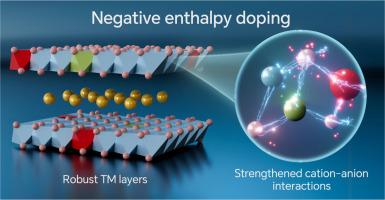Enthalpy-mediated local structural ordering stabilizes O3-type layered cathode for sodium-ion batteries
IF 20.2
1区 材料科学
Q1 CHEMISTRY, PHYSICAL
引用次数: 0
Abstract
O3-type Na0.9Ni0.4Fe0.1Mn0.5O2 (NFM) is a promising candidate material for sodium-ion batteries (SIBs) because of high theoretical capacity (220 mAh g−1), but largely suffers from rapid capacity decay due to severe phase transition caused by unstable transition metal (TM) layer gliding and anisotropic lattice strain accumulation upon cycling. Herein, we propose an enthalpy-doping strategy to precisely manipulate the local coordination ordering structure, thereby stabilize the TMO6 octahedral framework in the O3-type Na0.9Ni0.35Zn0.05Fe0.1Mn0.3Ti0.2O2 (NZFMT). Our findings demonstrate that the negative enthalpy characteristics of dopants reduce the ΔHmix of TM layers, thereby strengthening cation-anion interactions and promoting the formation of an ordered lattice structure. As anticipated, this tailored structure strategy favorably stabilizes layered structure to resist severe phase transition, leading to remarkable electrochemical improvements. The optimized NZFMT delivers a high capacity of 162.3 mAh g−1 with a prominent capacity retention of 96.3% after 100 cycles at 1 C (vs. 62.5% for NFM). Furthermore, the practical feasibility of an Ampere-hour-scale NZFMT||HC pouch cell is demonstrated by an energy density of 148 Wh kg−1, along with outstanding cycling stability (80.5% retention after 200 cycles at 0.5 C), outperforming many state-of-the-art O3-type cathodes. This work provides a universal enthalpy-mediated stabilization approach for designing high-energy-density SIB cathodes.

焓介导的局部结构有序稳定钠离子电池o3型层状阴极
o3型Na0.9Ni0.4Fe0.1Mn0.5O2 (NFM)具有很高的理论容量(220 mAh g−1),是一种很有前途的钠离子电池(sib)候选材料,但由于不稳定过渡金属(TM)层滑动和循环时各向异性晶格应变积累导致的严重相变导致容量快速衰减。在此,我们提出了一种焓掺杂策略来精确地操纵局部配位有序结构,从而稳定o3型Na0.9Ni0.35Zn0.05Fe0.1Mn0.3Ti0.2O2 (NZFMT)中的TMO6八面体框架。我们的研究结果表明,掺杂剂的负焓特性降低了TM层的ΔHmix,从而加强了正负离子的相互作用,促进了有序晶格结构的形成。正如预期的那样,这种定制的结构策略有利于稳定层状结构,以抵抗严重的相变,从而显著改善电化学性能。优化后的NZFMT可提供162.3 mAh g−1的高容量,在1c下循环100次后容量保持率为96.3% (NFM为62.5%)。此外,安培小时级NZFMT||HC袋状电池的实际可行性被证明为148 Wh kg - 1的能量密度,以及出色的循环稳定性(在0.5 C下200次循环后保持80.5%),优于许多最先进的o3型阴极。这项工作为设计高能量密度SIB阴极提供了一种通用的焓介导稳定化方法。
本文章由计算机程序翻译,如有差异,请以英文原文为准。
求助全文
约1分钟内获得全文
求助全文
来源期刊

Energy Storage Materials
Materials Science-General Materials Science
CiteScore
33.00
自引率
5.90%
发文量
652
审稿时长
27 days
期刊介绍:
Energy Storage Materials is a global interdisciplinary journal dedicated to sharing scientific and technological advancements in materials and devices for advanced energy storage and related energy conversion, such as in metal-O2 batteries. The journal features comprehensive research articles, including full papers and short communications, as well as authoritative feature articles and reviews by leading experts in the field.
Energy Storage Materials covers a wide range of topics, including the synthesis, fabrication, structure, properties, performance, and technological applications of energy storage materials. Additionally, the journal explores strategies, policies, and developments in the field of energy storage materials and devices for sustainable energy.
Published papers are selected based on their scientific and technological significance, their ability to provide valuable new knowledge, and their relevance to the international research community.
 求助内容:
求助内容: 应助结果提醒方式:
应助结果提醒方式:


